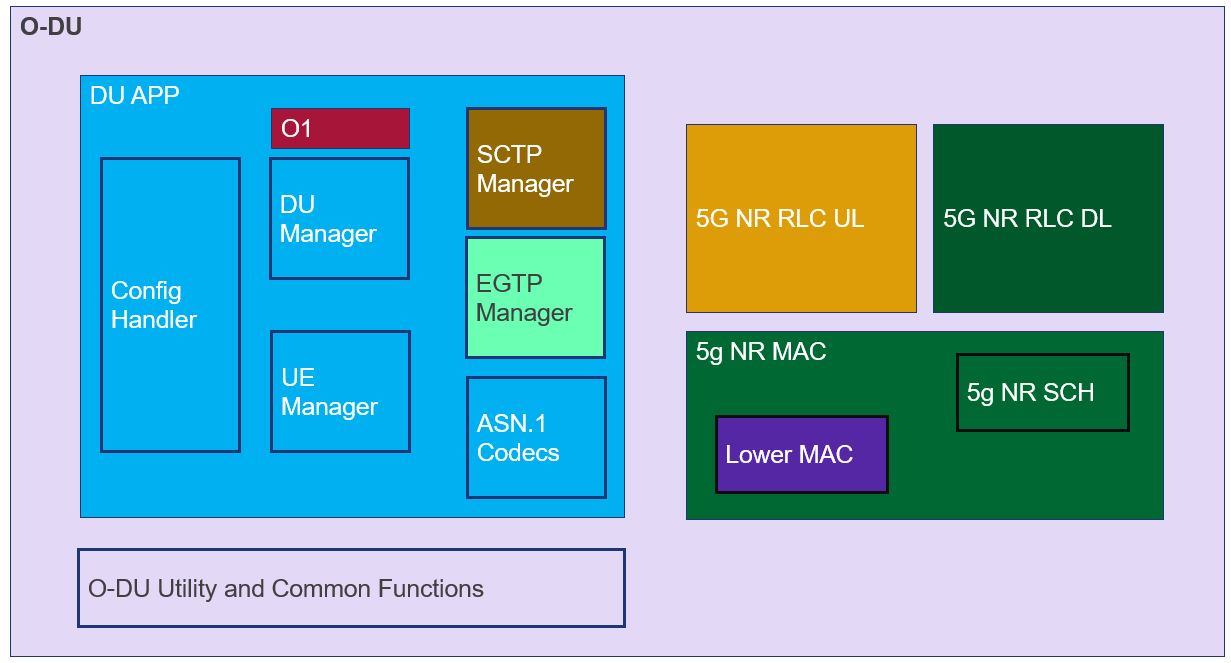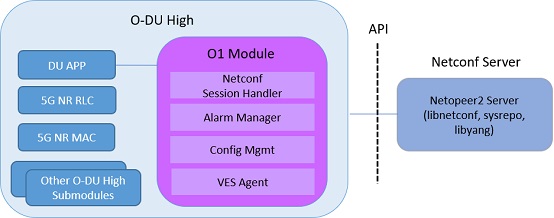O-DU High implements the functional blocks of L2 layers of a 5G NR protocol stack in Stand Alone (SA) mode. The L2 layers are NR RLC (Radio Link Control), NR MAC (Medium Access Control) and NR Scheduler. These layers aid in the transmission of traffic from the UE to the 5G Core network.
5G NR RLC layer provides services for transferring the control and data messages between MAC layer and O-CU (via DU App).
5G NR MAC layer uses the services of the NR physical layer (O-DU Low) to send and receive data on the various logical channels using multiplexing and demultiplexing techniques.
5G NR SCH layer allocates resources in UL and DL for cell and UE based procedures.
O-DU High Architecture
O-DU implements the functional blocks of L2 layer of a 5G NR protocol stack in SA (StandAlone) mode. These layers primarily include NR MAC, NR Scheduler and NR RLC layers.
O-DU modules are developed as shown in the below diagram.
...
O-DU High Thread Architecture
...
These modules contain platform specific files and support O-DU High functionality and message exchanges.
O1 Module
O1 Architecture
As shown
...
in the figure O1 module runs as a thread in O-DU High
...
. Alarm communication happens over a Unix socket between the O1 and O-DU threads. O1 module uses API calls for interacting with the Netconf server(Netopeer) and datastore(sysrepo) for providing the Netconf interface.
O1 architecture has following components:
Netconf
...
Session Handler: Subscribe to Netconf YANG modules and events. Register callback handler methods.
VES Agent : Sends the VES events to SMO
Alarm Manager: Stores and manages(add/updated/delete) alarms
...
.
...
Alarm Interface :
...
Provides an interface to O-DU High
...
threads for sending the alarm messages to O1 module over
...
Unix socket.
Config Interface : Interface to handle the configurations sent from SMO to the stack
Netopeer server: Serves the northbound SMO/OAM Netconf requests.
O-DU-High Interfaces
This section describes the other modules that O-DU High interfaces with, as shown in below diagram.
As shown above, O-DU High interfaces with the following modules:
O-CU: O-DU High communicates with O-CU on the F1AP interface. The control message exchanges are on F1-C while data message exchanges are on F1-U interfaces. The below F1AP messages on F1-C are implemented, as per 3GPP 38.473-f60 v15.3:
Interface Management
F1 Setup
gNB-DU Configuration Update
F1 Reset
UE Context Management
UE Context Setup
RRC Message Transfer
Initial UL RRC Message Transfer
DL RRC Message Transfer
UL RRC Message Transfer
RRC Delivery Report
Near RT RIC: O-DU High communicates with Near RT RIC on the E2 interface. The below E2AP messages are implemented, as per ORAN WG3.E2AP v01.00:
Global Procedures
E2 Setup
Near RT RIC Functional Procedures
RIC Subscription
RIC Indication
O-DU Low: O-DU High communicates with O-DU Low on the FAPI interface. The below FAPI messages are supported, as per FAPI interface files shared by Intel:
P5 messages - PHY mode control interface
PARAM.request/PARAM.response
CONFIG.request/CONFIG.response
START.request
STOP.request
STOP.indication
P7 messages - Main data path interface
DL_TTI.request
UL_TTI.request
SLOT.indication
UL_DCI.request
TX_Data.request
RX_Data.indication
CRC.indication
UCI.indication
RACH.indication
OAM: O-DU High communicates with OAM on the O1 interface.
O-DU High functionality
Cell Up and Broadcast Procedure
This section describes the cell-up procedure within O-DU High.
As seen in the above Figure, - The DU APP module of O-DU High sends F1 Setup Request to O-CU. This message contains a list of cells that the O-DU High has been configured with.
The O-CU responds with F1 Setup Response. This message contains a list of cells which must be activated.
The O-DU High scans the list of cells received and sends corresponding cell configurations to 5G NR MAC.
5G NR MAC, in-turn configures the 5G NR SCH. It also configures the O-DU Low via the Lower MAC module.
On receiving the cell config response, DU APP sends a gNB DU Config Update towards the O-CU. The O-CU responds with gNB DU Config Update ACK towards the O-DU High.
The DU APP now exchanges F1 Reset message with the O-CU to initialize the UE contexts.
DU APP sends Cell Start Req towards 5G NR MAC. This message is translated by the Lower MAC into the FAPI message START.request towards the O-DU Low.
On receiving START.request, O-DU Low begins to send slot indications towards 5G NR MAC via the lower MAC. The frequency of these slot indications is determined by the numerology(Mu) supported. 5G NR MAC forwards these slot indications to the 5G NR SCH and DU APP modules.
When the first slot indication reaches the DU APP, cell is marked as up.
The 5G NR SCH, keeps tracking the SSB and SIB1 ocassions on receiving regular slot indications. On detecting the relevant ocassion, 5G NR SCH schedules SSB/SIB1 and forwards the DL Scheduling Information to 5G NR MAC.
The 5G NR MAC mutiplexes the PDU and sends SSB/SIB1 packets towards the O-DU Low through the Lower MAC.
UE Related Procedure
The O-DU High supports
All physical channels - PBCH, PRACH, PDCCH, PDSCH, PUSCH, PUCCH
All control logical channels - UL CCCH, DL CCCH, UL DCCH, DL DCCH
All control transport channels - BCH, UL-SCH, DL-SCH, RACH
The above channels are used to achieve the below messages:
Cell broadcast of System Information which includes SSB and SIB1.
RACH Procedure
RACH Indication
Random Access Response
RRC Setup Request
RRC Setup
UE attach signalling flow
RRC Setup Complete
Registraton Request
Security Mode Command
Security Mode Complete
Registraton Accept
Registraton Complete
Several NAS Message Exchanges
RRC Reconfiguration
RRC Reconfiguration Complete
Below figure depicts the above call flow, inclusive of all interfaces:
...




